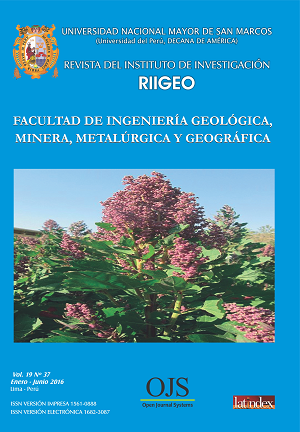Determination of the effect of extremely low frequency magnetic fields on spermatogenesis in mice
DOI:
https://doi.org/10.15381/iigeo.v19i37.12967Keywords:
Magnetic field, male fertility, electrical energy networks, electrical energy fields, sperm concentration, sperm mobilityAbstract
The objective of this article was to investigate the effects of chronic exposure to magnetic fields (MC) of existing environmental levels in the city of Lima on the reproductive health of male mice. Firstly, the information on the levels of the magnetic fields of electric power lines measured in Peru and other countries as well as the exposure limits of the international commission for protection against electromagnetic fields (ICNIRP) were reviewed to define the levels to which it would be exposed to biological material. The biological sample was 32 10-week-old male mice (Mus musculus) of the Balb C strain, with which four experimental groups of 8 mice each were formed, including a control group, one with dummy exposure (sham), a group exposed to 50μT CM and another exposed to 500μT, which were exposed during a spermatogenic cycle (35 days). The weight of the testicles and epididymis were evaluated. The sperm count was performed in a Neubauer chamber (hemocytometer) and sperm mobility according to the method recommended by the World Health Organization. The exposure system was based on 4 Helmholtz coils, measuring the CM of each coil using the Narda EFA 300 electromagnetic field analyzer and monitoring during the study was carried out every two weeks using the same analyzer. The results were evaluated using the SPSS 22 statistical package for Windows. Using the Shapiro-Wilk and Leneve tests for the normality of the data and the Anova and Kruskal Wallis tests (according to the data they had a normal distribution or not) to know if the groups of any variable had equal means or not. It was shown that, in general terms, chronic exposure to MCs with existing levels in places near high-voltage lines in the city of Lima did not affect the weight of the reproductive organs, but it did affect concentration and sperm mobility. In conclusion, the study showed that for the levels of chronic exposure to MC evaluated if there is impairment of the reproductive health of the exposed male Balb C mice.
Downloads
Published
Issue
Section
License
Copyright (c) 2016 Víctor Cruz O., Martha Valdivia C.

This work is licensed under a Creative Commons Attribution-NonCommercial-ShareAlike 4.0 International License.
AUTHORS RETAIN THEIR RIGHTS:
a. Authors retain their trade mark rights and patent, and also on any process or procedure described in the article.
b. Authors retain their right to share, copy, distribute, perform and publicly communicate their article (eg, to place their article in an institutional repository or publish it in a book), with an acknowledgment of its initial publication in the Rev. Inst. investig. Fac. minas metal cienc. geogr.
c. Authors retain theirs right to make a subsequent publication of their work, to use the article or any part thereof (eg a compilation of his papers, lecture notes, thesis, or a book), always indicating the source of publication (the originator of the work, journal, volume, number and date).























